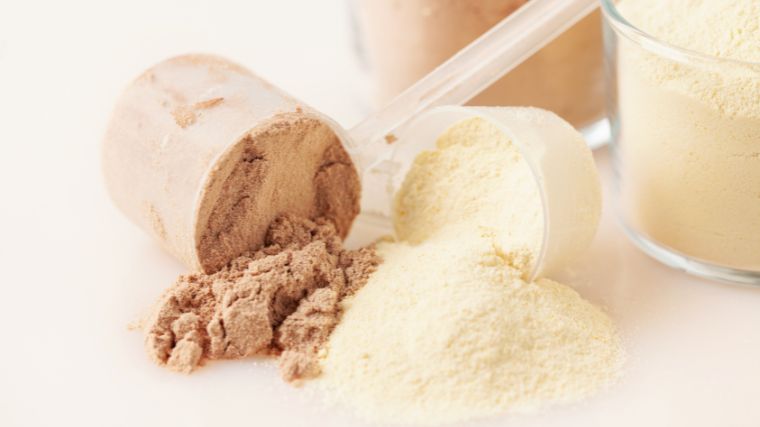If you’re on a muscle gain or fat loss journey, let’s face it, you’ve got protein intake goals. If you’ve added whey protein to your diet to help you get there, you may have come across grass-fed whey protein. It sounds nice, but what is it really?
Grass-fed means that the milk the whey was separated from came from cows that ate a natural diet of grass and plants after weaning off of their mothers’ milk. There’s a small purported difference in nutrients — the dairy retains more healthy fats including omega-3s, conjugated linoleic acid (CLA), and antioxidants.

Let’s take a closer look at the world of grass-fed whey and how these extra nutrients can theoretically impact your fitness journey and overall health.
Editor’s Note: The content on BarBend is meant to be informative in nature, but it should not be taken as medical advice. When starting a new training regimen and/or diet, it is always a good idea to consult with a trusted medical professional. We are not a medical resource. The opinions and articles on this site are not intended for use as diagnosis, prevention, and/or treatment of health problems. They are not substitutes for consulting a qualified medical professional.
- What Is Grass-Fed Whey Protein?
- Benefits of Grass-Fed Whey Protein
- Potential Drawbacks of Grass-Fed Whey Protein
What Is Grass-Fed Whey Protein?
Make no mistake, the “grass-fed” moniker doesn’t mean that this type of whey isn’t an animal product. The US Department of Agriculture (USDA) defines “grass-fed” to mean that the majority of the nutrients that the cows receive in their lives comes from grass, forage, and legumes. (1)
While some grass-fed products may claim to come from humanely treated cows, the term only refers to the cows’ diet and not how they were treated throughout their lifetimes.
The USDA indicates that the animals must have access to pastures, but it does not guarantee that they fully lived freely outdoors — just that they mainly consumed grass instead of grain.
What Is Whey Protein?
Whey protein is a nutritional supplement, almost universally provided as a powder, meant to augment a high-protein diet. It’s a complete protein source, which means it contains all nine essential amino acids that your body needs and can’t produce on its own. (2)(3) This includes branched chain amino acids (BCAAs) — found in the popular muscle-building supplements.
Whey is particularly high in leucine, which is key for stimulating muscle protein synthesis. (4) It’s also high in cysteine, a non-essential amino acid that can raise your levels of glutathione to fight inflammation and diseases. (2) Grass-fed whey from beef is also said to have high levels of glutathione. (5)

[Read More: The 12 Best Supplements for Muscle Growth (Spring 2023 Update)]
Whey is also considered a quality protein source which means it is quickly absorbed, digested, and available to your skeletal muscles. (2) It can help you build muscle when paired with resistance training.
How Is Grass-Fed Whey Protein Different?
Grass-fed protein contains all the same nutritional properties as whey protein, but grass-fed animal products such as milk or beef may have some additional significant benefits. Some evidence has shown them to contain higher levels of omega-3s, antioxidants, iron, or conjugated linoleic acid than regular milk and beef. (5)(6)(7) CLA, in particular, has some limited but compelling support for reducing body fat. (8)
There hasn’t been research or studies done on grass-fed whey protein powder, but since it is derived from milk from grass-fed cows, the above information may also apply.
Sources of Grass-Fed Whey Protein
If you want to get grass-fed whey protein from food, you can choose animal-based protein sources like milk or beef that have been labeled as grass-fed. Some common options include:
- Grass-fed milk
- Grass-fed yogurt
- Grass-fed beef
Types of Grass-Fed Whey Protein Supplements
Grass-fed dairy has more fat which retains vitamins, antioxidants, and helpful fatty acids. (6) When processing liquid whey into protein powder, a lot of the fat is removed. In whey isolate and whey hydrolysate supplements, even more of the fat and lactose is removed.
Since the fat has been removed, if you are choosing a grass-fed whey protein supplement, it may not have retained any extra nutritional benefits.
All three types of whey protein supplements come in grass-fed form, depending on the brand:
- Grass-Fed Whey Concentrate
- Grass-Fed Whey Isolate
- Grass-Fed Whey Hydrolysate
Benefits of Grass-Fed Whey Protein
Grass-fed dairy and beef products have higher nutrient profiles than grain-fed food sources of whey protein. They’re also higher in fatty acids and antioxidants that provide health benefits to athletes and nonathletes alike. (5)
Theoretically, grass-fed whey protein powder may hold the same higher nutrient density, but there is no research on this and some nutrients may be removed through processing. Here’s how the potential benefits of grass-fed whey protein can help you out.
More Omega-3s
Protein from grass-fed sources tends to have higher levels of omega-3 fatty acids. (5) Omega-3s have been researched for many years and have been repeatedly shown to potentially benefit your cardiac health, joint health, and brain health. (9)(10)(11)
Omega-3s also have potential benefits on exercise and training adaptations. They’ve been shown to have anti-inflammatory properties that can reduce delayed onset muscle soreness (DOMS), muscle damage, and improve recovery. (12) Omega-3s increase nitric oxide production, which widens and relaxes your blood vessels, leading to better blood flow. Improved vasodilation has many benefits for cardio and strength training. (13)

[Read More: The 9 Best Ashwagandha Supplements (2023 Update)]
Some evidence shows that when combined with resistance training and nutrition, omega-3s can also enhance muscle protein synthesis leading to skeletal muscle growth. (12) They contribute to overall muscle health and can be an important part of the hypertrophy puzzle.
Contains CLA
Grass-fed whey protein sources are shown to contain an important omega-6 acid called conjugated linoleic acid. Research on CLA is ongoing, but it has received some attention for being potentially beneficial to body composition changes. (5)
Much of the data on CLA were retrieved from animal studies. Recently, some studies on adult humans showed that taking high doses of CLA helped them to lose body fat and increase lean body mass. (14) However, more research is needed, and it’s difficult to say that CLA directly influenced those results.
Another promising paper showed that combining CLA with creatine and whey protein helped subjects increase their strength and muscle mass during a resistance training program. (15)
High In Antioxidants
Grass-fed cows yield milk that is higher in antioxidants. These include beta-carotene, a precursor to vitamin A, vitamin E, and glutathione (GT). (5)(6) Antioxidants fight inflammation and benefit your overall health.
For example, Beta-carotene and vitamin A support your eye health, and vitamin E supports your skin and your cognitive health. (16) Glutathione is a powerful antioxidant shown to reduce inflammation and fight diseases. (2)
A Good Source of Iron
Grass-fed milk also contains more iron than grain-fed sources. (7) Having sufficient iron levels can be beneficial to strength training. (17)
Iron helps transport oxygen to your muscles during exercise which can improve your athletic performance. It also plays a role in energy metabolism. (17) An iron deficiency or anemia can affect your gym performance, energy levels, and skeletal muscle health. (18)
Grass-Fed Whey Protein Powder Benefits
When it comes to grass-fed whey protein powder supplements, there are no current studies on its extra nutritional benefits as compared to standard whey protein powder. However, it does retain all of the many benefits that whey protein has on strength training.

[Read More: The 15 Best Home Gyms (Spring 2023 Update)]
Since it contains all of your amino acids, it’s a high-quality, bioavailable, complete protein source that is quickly absorbed. (2) When combined with resistance training, it’s shown to help you build muscle by increasing muscle protein synthesis. (19) Whey protein can also help you retain lean muscle while losing body fat. (20) It supports recovery from exercise and can lead to increasing your strength over time. (21)
Potential Drawbacks of Grass-Fed Whey Protein
Grass-fed whey protein may pack some extra nutrients, but there are certainly some potential drawbacks as well.
Not Highly Researched
There are currently no substantive studies on the benefits of grass-fed whey as compared to regular whey protein powder. If you are looking for a nutritional reason to choose it over a regular whey protein powder, there unfortunately is no conclusive science to support it. Any potential extra nutrients derived from grass-fed whey may be removed during processing.
Inconsistent Products
While the label “grass-fed” needs to meet the USDA’s standards, there are a wide array of products and companies that use this label. There is not a standardized type of grass being fed to the cows, and the type and amount of grass they are eating could change the nutrient profiles of the food. (22)
May Cause Digestive Issues
Like whey protein, grass-fed whey protein may cause digestive issues including stomach pain, bloating, and gas. Grass-fed whey protein contains lactose and if you are sensitive to that, it may cause issues for you.

[Read More: 5 At-Home Workouts for Strength, Muscle Growth, Power, and More]
Grass-fed whey protein isolate and hydrolysate have less lactose than grass-fed whey concentrate and may cause less symptoms. They still retain some dairy and can be problematic for you if you are lactose intolerant.
More Expensive
Grass-fed whey protein tends to be even pricier than whey protein. You can always opt for getting grass-fed protein through food sources, although organic food is also usually more expensive than non-organic.
Your Takeaways
Let’s break down the information above into grass-sized bites for you to take away on your next trip to the protein powder aisle.
- Grass-fed whey protein is whey protein that comes from cows that have mainly eaten grass instead of grain during their lives after weaning off of their mothers’ milk.
- You can get grass-fed whey protein from grass-fed meat, dairy, and supplements.
- Grass-fed protein sources may retain more fat and nutrients including omega-3s, CLA, antioxidants, and iron.
- Omega-3s, CLA, antioxidants, and iron all can benefit your overall health and support your fitness goals by reducing inflammation.
- Whether or not it has extra nutrients, grass-fed whey protein contains all the same high-quality, muscle-building properties of whey protein.
- Grass-fed whey protein is not highly researched and its extra nutrients may be lost during processing. Grass-fed is not a standardized term, and different types of grass can yield different nutrient levels. It also may cause digestive issues and is more expensive.
Should You Go Grass-Fed?
Supplement companies tend to slap lots of buzzwords onto their labels and they don’t need scientific evidence to back up their claims. When it comes to grass-fed whey protein products, there’s no research that suggests it has extra nutrients in it. Grass-fed protein food sources may contain a little bit more fat, omega-3s, CLA, and antioxidants which can all be beneficial to your health.
If the treatment of animals is important to you, there is unfortunately no guarantee that grass-fed products come from cows that lived free and humane lives — just that they ate grass. If that’s a hard line for you, you may want to explore other options. You can still build muscle on a vegan diet, so you may want to try out a plant-based protein powder in your next post-workout shake.
References
- USDA Certified Organic: Understanding the Basics. U.S. Department of Agriculture. https://www.ams.usda.gov/services/organic-certification/organic-basics
- Hoffman JR, Falvo MJ. Protein – Which is Best? J Sports Sci Med. 2004 Sep 1;3(3):118-30.
- Lopez MJ, Mohiuddin SS. Biochemistry, Essential Amino Acids. [Updated 2023 Mar 13]. In: StatPearls [Internet]. Treasure Island (FL): StatPearls Publishing; 2023 Jan-.
- Wolfe RR. Branched-chain amino acids and muscle protein synthesis in humans: myth or reality? J Int Soc Sports Nutr. 2017 Aug 22;14:30.
- Daley CA, Abbott A, Doyle PS, Nader GA, Larson S. A review of fatty acid profiles and antioxidant content in grass-fed and grain-fed beef. Nutr J. 2010 Mar 10;9:10.
- Alothman M, Hogan SA, Hennessy D, Dillon P, Kilcawley KN, O’Donovan M, Tobin J, Fenelon MA, O’Callaghan TF. The “Grass-Fed” Milk Story: Understanding the Impact of Pasture Feeding on the Composition and Quality of Bovine Milk. Foods. 2019 Aug 17;8(8):350.
- Średnicka-Tober D, Barański M, Seal CJ, Sanderson R, Benbrook C, Steinshamn H, Gromadzka-Ostrowska J, Rembiałkowska E, Skwarło-Sońta K, Eyre M, Cozzi G, Larsen MK, Jordon T, Niggli U, Sakowski T, Calder PC, Burdge GC, Sotiraki S, Stefanakis A, Stergiadis S, Yolcu H, Chatzidimitriou E, Butler G, Stewart G, Leifert C. Higher PUFA and n-3 PUFA, conjugated linoleic acid, α-tocopherol and iron, but lower iodine and selenium concentrations in organic milk: a systematic literature review and meta- and redundancy analyses. Br J Nutr. 2016 Mar 28;115(6):1043-60.
- Lehnen TE, da Silva MR, Camacho A, Marcadenti A, Lehnen AM. A review on effects of conjugated linoleic fatty acid (CLA) upon body composition and energetic metabolism. J Int Soc Sports Nutr. 2015 Sep 17;12:36.
- DiNicolantonio JJ, O’Keefe JH. The Benefits of Marine Omega-3s for the Prevention and Treatment of Cardiovascular Disease. Mo Med. 2019 Sep-Oct;116(5):404-408.
- Miles EA, Calder PC. Influence of marine n-3 polyunsaturated fatty acids on immune function and a systematic review of their effects on clinical outcomes in rheumatoid arthritis. Br J Nutr. 2012 Jun;107 Suppl 2:S171-84.
- Dighriri IM, Alsubaie AM, Hakami FM, Hamithi DM, Alshekh MM, Khobrani FA, Dalak FE, Hakami AA, Alsueaadi EH, Alsaawi LS, Alshammari SF, Alqahtani AS, Alawi IA, Aljuaid AA, Tawhari MQ. Effects of Omega-3 Polyunsaturated Fatty Acids on Brain Functions: A Systematic Review. Cureus. 2022 Oct 9;14(10):e30091.
- Gammone MA, Riccioni G, Parrinello G, D’Orazio N. Omega-3 Polyunsaturated Fatty Acids: Benefits and Endpoints in Sport. Nutrients. 2018 Dec 27;11(1):46.
- Żebrowska A, Mizia-Stec K, Mizia M, Gąsior Z, Poprzęcki S. Omega-3 fatty acids supplementation improves endothelial function and maximal oxygen uptake in endurance-trained athletes. Eur J Sport Sci. 2015;15(4):305-14.
- Benjamin S, Prakasan P, Sreedharan S, Wright AD, Spener F. Pros and cons of CLA consumption: an insight from clinical evidences. Nutr Metab (Lond). 2015 Feb 3;12:4.
- Cornish SM, Candow DG, Jantz NT, Chilibeck PD, Little JP, Forbes S, Abeysekara S, Zello GA. Conjugated linoleic acid combined with creatine monohydrate and whey protein supplementation during strength training. Int J Sport Nutr Exerc Metab. 2009 Feb;19(1):79-96.
- Carlsen MH, Halvorsen BL, Holte K, Bøhn SK, Dragland S, Sampson L, Willey C, Senoo H, Umezono Y, Sanada C, Barikmo I, Berhe N, Willett WC, Phillips KM, Jacobs DR Jr, Blomhoff R. The total antioxidant content of more than 3100 foods, beverages, spices, herbs and supplements used worldwide. Nutr J. 2010 Jan 22;9:3.
- Stugiewicz, M., Tkaczyszyn, M., Kasztura, M., Banasiak, W., Ponikowski, P. and Jankowska, E.A. (2016), The influence of iron deficiency on the functioning of skeletal muscles: experimental evidence and clinical implications. Eur J Heart Fail, 18: 762-773.
- Hinton PS. Iron and the endurance athlete. Appl Physiol Nutr Metab. 2014 Sep;39(9):1012-8.
- Hulmi JJ, Lockwood CM, Stout JR. Effect of protein/essential amino acids and resistance training on skeletal muscle hypertrophy: A case for whey protein. Nutr Metab (Lond). 2010 Jun 17;7:51.
- Paddon-Jones D, Westman E, Mattes RD, Wolfe RR, Astrup A, Westerterp-Plantenga M. Protein, weight management, and satiety. Am J Clin Nutr. 2008 May;87(5):1558S-1561S.
- Hill KM, Stathis CG, Grinfeld E, Hayes A, McAinch AJ. Co-ingestion of carbohydrate and whey protein isolates enhance PGC-1α mRNA expression: a randomised, single blind, cross over study. J Int Soc Sports Nutr. 2013 Feb 12;10(1):8.
- Krusinski, L., Sergin, S., Jambunathan, V., Rowntree, J., & Fenton, J.I. (2022). Attention to the Details: How Variations in U.S. Grass-Fed Cattle-Feed Supplementation and Finishing Date Influence Human Health. Frontiers in Sustainable Food Systems.
Featured Image: NatalyaBond / Shutterstock